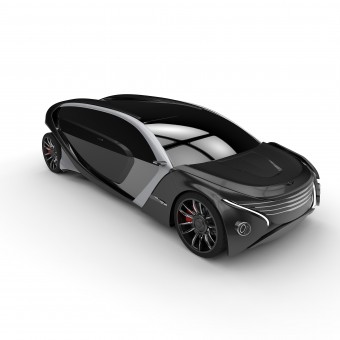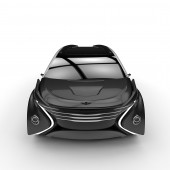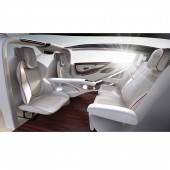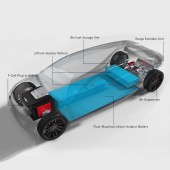
| THE AWARD |
| CATEGORIES |
| REGISTRATION |
| SUBMIT YOUR WORK |
| ENTRY INSTRUCTIONS |
| TERMS & CONDITIONS |
| PUBLICATIONS |
| DATES & FEES |
| METHODOLOGY |
| CONTACT |
| WINNERS |
| PRESS ROOM |
| GET INVOLVED |
| DESIGN PRIZE |
| DESIGN STORE |
| THE AWARD | JURY | CATEGORIES | REGISTRATION | PRESS | WINNERS | PUBLICATIONS | ENTRY INSTRUCTIONS |
Conceptum Works: Neue Klasse Luxury Multi-Purpose Vehicle by Ying Hern Pow |
Home > Winners > Design #26783 >Interview |
 |
|
FS: What is the main principle, idea and inspiration behind your design?
YP: This project revolves around one and only one main purpose: can a car’s cabin be meaningful? Roy M. Goodman, famous New York City mayor once said “Remember that happiness is a way of travel - not a destination.” And it is this very phrase that this project was inspired by and the purpose of the design can almost be felt throughout the entire concept ideation process.
FS: What has been your main focus in designing this work? Especially what did you want to achieve?
YP: My main focus in designing this work has been on the idea of an exciting Multi-purpose Vehicle (MPVs). MPVs are usually bought by family men, not usually by desire, but more by requirement. Buyers of MPVs value the space and utility qualities, to ferry their wife and kids and whatever else they bring along with them for a journey, school, work alike. As a result, MPVs are generally designed to be spacious and biased towards comfort, and not so much towards driving enjoyment. After all, when you have your kids in tow, the last thing you want to do is to throw your ride into corners vigorously. The bi-products of MPVs, unfortunately, are usually their overtly bulky body style and dull image. So I want to change all of these while giving the said MPV a very sociable cabin.
FS: What are your future plans for this award winning design?
YP: Possibly to exchange contact with relevant automotive industries for me to work for them after my impending graduation.
FS: How long did it take you to design this particular concept?
YP: 8 months. And 2 days.
FS: Why did you design this particular concept? Was this design commissioned or did you decide to pursuit an inspiration?
YP: As a keen driver, I have always dreaded the days that I would eventually drive one of these functional cars, out of necessity rather than desirability. This motivated me to work on such project instead of what most young aspiring design students would do – supercars, sports cars, etc. It was a tough decision, having to select the scope of research to work on.
FS: Is your design being produced or used by another company, or do you plan to sell or lease the production rights or do you intent to produce your work yourself?
YP: I intend to sell my idea to any interested companies, if they are willing to buy, that is.
FS: What made you design this particular type of work?
YP: Cars are not just tools bringing people from point A to point B. Passengers constantly seek greater comfort and luxury from the very transportation they are commuting in. Furthermore, during the course of travel, social hierarchy issue exists within the cabin, particularly in the MPV (Multi-purpose Vehicle) segment.
FS: Who is the target customer for his design?
YP: Family guy, young ones.
FS: What sets this design apart from other similar or resembling concepts?
YP: So what makes the Neue Klasse different to everyone else’s? For starters, the Neue Klasse redefines a new market segmentation that shares the same functionality as luxury MPVs, the same stance as a stationwagon, similar wheelbase as a luxury stretch and the same price point of a luxury sedan. The Neue Klasse is the epitome of a luxury MPV of a new era that typical Asian families would love to drive: spacious and luxurious cabin, sociable cabin layout, sustainable and good image for the driver. The differences between the Neue Klasse and its close competitors in terms of car length, wheelbase & price: cheaper than the most spacious luxobarge; better looking as an MPV What makes the Neue Klasse even more special is its groundbreaking drive train system that utilises a combination of Lithium Sulphur batteries and a range extender powered by biofuel (renewable energy such as oil palm, corn husks, etc). Lithium Sulphur (Li-S) battery is a fairly new source of energy. A research team from the University of Waterloo has synthesized a prototype of a lithium-sulphur rechargeable battery that, thanks to its peculiar nanoscale structure, can store three to five times the power of a conventional lithium-ion battery in the same volume while being significantly lighter and potentially cheaper to manufacture.
FS: How did you come up with the name for this design? What does it mean?
YP: As the name suggests, "Neue Klasse" defines a new class segment in the automotive industry: Longer wheelbase than a luxury sedan, as wide as an MPV, and features a new sociable interior.
FS: Which design tools did you use when you were working on this project?
YP: Mostly digital for the design: Rhinoceros, Photoshop and After Effects. For physical model, CNC-ed chemical woods and 3D printed parts.
FS: What is the most unique aspect of your design?
YP: The Neue Klasse Concept is characterized by distinctive and radical proportions that mix elements of an estate with those of a coupé/shooting brake. The body features a proportionate stance – with a height of less than 1.6 meters – and generous length and width – 5.14 and 2 meters respectively. The concept has a very long wheelbase, 3.9 meters long to be exact, and to balance the proportion and minimise the horizontality of the car, big wheels like Rolls Royce Phantom’s have been fitted on the car, together with thick A-pillar in silver satin that creates a more vertical visual flow to the side profile. The flowing, dynamic profile is defined by the hood and by the sweeping, accelerating curve that gives form to the windscreen and roofline silhouette, ending with a long, well integrated rear claddings, which reinforces the fastback effect. The side profile has an imposing ‘D’ bulge that defines the character of the car, this ‘D’ design cue can be felt in the interior of the car too. A unique triangular rear side skirt adds dynamism and the sculpted looks to the car, complemented by a chrome side fender located by the front wheels. The styling was repeatedly hampered by Rhino’s inability to sculpt more sophisticated form and surfaces. The repercussion was a good two months gone for trial and errors to achieve the desired looks and styling. Color choice was deemed to be challenging because it is crucial in getting the right feel. Gun metal grey is the mainstay of the color scheme as I believe that this color is what makes a car look futuristic and bring out its metallic surfaces.
FS: Who did you collaborate with for this design? Did you work with people with technical / specialized skills?
YP: I worked alone.
FS: What is the role of technology in this particular design?
YP: What makes the Neue Klasse special is its groundbreaking drive train system that utilises a combination of Lithium Sulphur batteries and a range extender powered by biofuel (renewable energy such as oil palm, corn husks, etc). Lithium Sulphur (Li-S) battery is a fairly new source of energy. A research team from the University of Waterloo has synthesized a prototype of a lithium-sulphur rechargeable battery that, thanks to its peculiar nanoscale structure, can store three to five times the power of a conventional lithium-ion battery in the same volume while being significantly lighter and potentially cheaper to manufacture.
FS: What are some of the challenges you faced during the design/realization of your concept?
YP: Designing a car is not an easy task, nor is it meant to be a one-man show. In the car design industry, it is always the case where there is an exterior designer, interior designer and material designer for the design side, while more engineers from the mechanical engineering side. In my case however, I had to make do with a one-man team while tackling the main objectives of the project. Many of the design aspects were touch-and-go while the important bits were more focused and elaborately engineered. I have managed to complete a car design project despite all these issues, which is incredible considering the project was done without prior training or education in car design. There are, however, several setbacks in the project that could have jeopardized the progress of the work: Bad time management, persistent software bugs that led to flaws in CAD, and more. These were eventually resolved without incurring serious issues. However, more daunting aspects of the project came in hard at the start of the second semester as interior packaging has stumbled upon a blocking stone: The dimensions of the car did not tally with the requirement of the interior packaging. It was a slow and painful process whereby each of the prevailing issues was overcome with great deal of effort, one at a time. The bottom line is, always give margin for errors, in this case, more time, to undo the unexpected mistakes. This will serve as a close reminder to whatever I do in my future endeavors.
FS: Thank you for providing us with this opportunity to interview you.
A' Design Award and Competitions grants rights to press members and bloggers to use parts of this interview. This interview is provided as it is; DesignPRWire and A' Design Award and Competitions cannot be held responsible for the answers given by participating designers.
| SOCIAL |
| + Add to Likes / Favorites | Send to My Email | Comment | View Press-Release |





